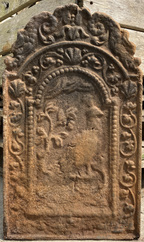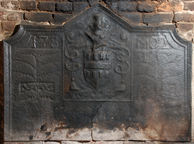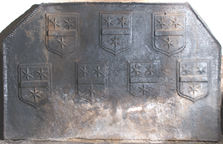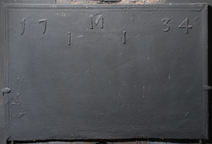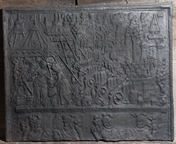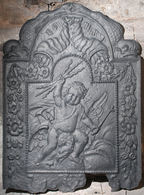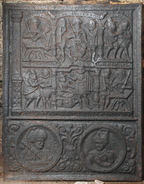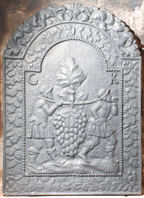-
1297
Description: Arched rectangular shaped central panel with bead-on-fillet edging; a peacock, facing right, standing on a plinth, with foliage to the left and clouds above; arched rectangular shaped border with fillet edging, symmetrical floral fronds descending from a scallop shell, top centre, with a scallop shell inside each shoulder; at base, detail mostly obscured by corrosion but the numerals '17 24' are faintly visible in the bottom corners; on top, a pair of mirrored, stylised sea serpents with a central arrangement of foliage.
Notes: The image of the peacock may be an adaptation of an engraving (1654-62) by Wenceslaus Hollar, after Francis Barlow, in which a peacock also stands on a plinth. The small size of this fireback makes it likely that it was intended to be fixed to the back of a grate. A copy of a fireback of this design features in Gleanings from Old English Firesides by Arthur Todhunter.
Copies of this fireback are known.
Inscription: 17 24
- Decoration tags:
- 'Dutch' (shape)
- fillet (edging)
- whole carved pattern
- animals
Manufactured: in 1724 in England.
Current location: Authentic Reclamation, Lymden Lane, Ticehurst, East Sussex, England.
Citation: Todhunter, A., c.1910, Gleanings from Old English Firesides (New York, Arthur Todhunter), p. 3.
- Attached to series:
- British 'Dutch' style firebacks
- 1724 series
-
700
Description: Cavetto-canted rectangle with central pediment; cyma-reversa moulded edging; central pedimented panel, fillet edged, with shield, helm, crest and mantling of the May family; on either side, an incised floral pattern of a stem and six branches, rising from a rectangular, low-relief panel of two images of horsemen; above, the inscription in low relief.
Notes: The arms of May: Gules, a fess between eight billets Or; crest: Out of a ducal coronet Or, a lion’s head gules bezanty; the same armorial stamp appears to have been used on an unnamed iron graveslab in Ticehurst church. The initials are probably those of Susanna May (c1653-1718), heir to Pashley, in Ticehurst, who had married her distant cousin, Sir Robert May, in 1686. The May family had been involved in the iron industry in the 16th and early 17th centuries, but were no longer active a century later. Incised decoration on firebacks is uncommon, the decoration probably having been incised into the pattern board.
Inscription: 17S M02
Arms: May of Pashley, Ticehurst
- Decoration tags:
- rectangular with canted top corners and triangular arch (shape)
- cyma reversa/ogee (edging)
- carved stamps
- whole carved pattern
- armorial
- text
- animals
- humans
Manufactured: in 1702 in the Weald area of England.
Current location: in private hands, Ticehurst, East Sussex, England.
- Attached to series:
- Personal armorial firebacks
-
722
Description: Canted rectangular shape; twisted rope edging (top and sides); shield with recessed edges repeated seven times (3 and 4): a fess between three mullets of six points.
Notes: The arms are those of Courthope of Whiligh in Ticehurst; blazon: argent, a fess azure between three estoiles sable (two and one). Shown are molets of six points which have straight rays instead of (properly) estoiles which have wavy ones. However, the 1643/4 iron graveslab of David Barham of Snape, in Wadhurst church, has the same arms (also with molets instead of estoiles), which were those of his mother who was a Courthope.
Arms: Courthope, of Whiligh in Ticehurst
- Decoration tags:
- rectangular with canted top corners (shape)
- rope (edging)
- carved stamps
- heraldic
- armorial
Manufactured: in the late-16th to early-17th century in the Weald area of England.
Current location: in private hands, Ticehurst, East Sussex, England.
- Attached to series:
- Personal armorial firebacks
- Courthope arms series
-
960
Description: Rectangular with two-stepped top; twisted rope edging to top of main plate and sides of lower step, reused frame moulding for sides of main plate; top centre, stamp formed of a talbot statant guardant upon a wreath; date below crest stamp; initials in triad, separated by, and below, date.
Notes: Straight elements in the letters and numbers are formed of the same short lengths of twisted rope that are used to form the edging; curved elements appear to have been formed by hand drawing in the casting sand; the talbot crest, which in this instance has been over pressed and shows the shape of the backing, has been seen on other firebacks indicating a common source, and is associated with firebacks with a stepped-shape.
Inscription: N 1615 W / K
- Decoration tags:
- stepped (shape)
- rope and wood moulding (edging)
- simple stamps
- carved stamps
- individual letters
- individual numbers
- heraldic
- text
Manufactured: in 1615 in the Weald area of England.
Current location: Titsey Place, Titsey, Surrey, England.
- Attached to series:
- Talbot crest series
- Stepped firebacks
-
961
Description: Rectangular; ogee-moulded edging on top and side edges; symmetrical layout of date and initials; date split between left and right sides, initials in centre, arranged in triad.
Notes: One of a series of backs dating to the 1730s and 40s using very similar sets of letters and numerals.
Inscription: 17 I M I 34
- Decoration tags:
- rectangular (shape)
- ovolo (edging)
- carved stamps
- individual letters
- individual numbers
- text
Manufactured: in 1734 in the Weald area of England.
Current location: in private hands, Titsey, Surrey, England.
- Attached to series:
- 1730s-40s, date & initial series
-
701
Description: Arched, rectangular central panel with fillet edging; figure of Abundance holding a sickle and a Horn of Plenty, a child, also holding a sickle, to the right, a seated dog to the left, framed by trees; fillet-edged border with a plant pot each side, lilies issuing therefrom; above an oval shield of arms, a grotesque face above, supported by two lions.
Notes: Abundance was one of many allegorical figures to feature in the Iconologia, first published by Cesare Ripa in 1593. The style of the fireback derives from those produced in the Siegenland of NW Germany for the Dutch market, but this example may be a pastiche produced for the French market.
Copies of this fireback are known.
- Decoration tags:
- 'Dutch' (shape)
- fillet (edging)
- whole carved pattern
- pictorial
- allegorical
- armorial
- animals
- humans
- plants
Manufactured: in the late-17th to early-18th century possibly in the Lorraine area of France.
Current location: Tiverton Castle, Tiverton, Devon, England.
- Attached to series:
- 'Dutch' Miscellaneous Firebacks
-
703
Description: Rectangular; cavetto moulded edging; pictorial scene of the siege of Bethulia, with Judith placing the severed head of Holofernes into the bag held by her maid; in the lower panel are the top parts of four knightly figures.
Notes: The design is after one by the pattern-maker, Philipp Soldan, and derived from a woodcut of an engraving by Israhel van Meckenhem; it illustrates scenes from the Apocryphal book of Judith.
- Decoration tags:
- rectangular (shape)
- cavetto (edging)
- whole carved pattern
- pictorial
- biblical
- humans
Manufactured: in the late-16th century in the Eifel area of Germany.
Current location: Tiverton Castle, Tiverton, Devon, England.
- Attached to series:
- Stoveplates
-
704
Description: Arched rectangular central panel with bead edging; pictorial figure of a winged child holding a thunderbolt in his right hand and a sceptre in his left hand, on a ground of clouds; arched rectangular border with astragal and cavetto moulded edging; two cornucopiae, flowers and leaves tumbling from them and hanging suspended down the sides; on top, two sea serpents.
Notes: The figure is of Zeus/Jupiter as a child.
Copies of this fireback are known.
Inscription: 16 [...]
- Decoration tags:
- 'Dutch' (shape)
- cavetto (edging)
- whole carved pattern
- pictorial
- mythological
- text
- humans
Manufactured: in the mid- to late-17th century in the Siegerland area of Germany.
Current location: Tiverton Castle, Tiverton, Devon, England.
- Attached to series:
- 'Dutch' Miscellaneous Firebacks
-
705
Description: Stove side plate; cavetto moulded edging; upper panel, Ionic column and pedestal to left; six courtly scenes separated by arches and columns; lower panel, two circular frames, each with a figure, male to the left, female to the right, decorative scroll work between.
Notes: Possibly a graphic retelling of the parable of the Unjust Steward (Luke 16: 1-13)
Inscription: [illegible]
- Decoration tags:
- rectangular (shape)
- flanged (edging)
- whole carved pattern
- pictorial
- biblical
- text
- humans
Manufactured: in the late-16th to early-17th century possibly in the Eifel area of Germany.
Current location: Tiverton Castle, Tiverton, Devon, England.
- Attached to series:
- Stoveplates
-
706
Description: Arched rectangular central panel, with bead edging; pictorial, two men in 17th century dress, on a ground, carrying a huge bunch of grapes slung from a pole between them, behind are vine leaves; the initials located below the top corners; arched rectangular border, fillet edging, containing vine leaves and grapes; above, symmetrical swirling foliage.
Notes: The scene, drawn from the Old Testament, represents Joshua and Caleb carrying the bunch of grapes from the valley of Eshcol in the land of Canaan, back to Moses and the children of Israel (Numbers 13: 23-4); a small number of firebacks bear the initials, GK; it is not known to whom they refer, but dated examples are of 1700.
Copies of this fireback are known.
Inscription: G K
Manufactured: in 1700 in the Siegerland area of Germany.
Current location: Tiverton Castle, Tiverton, Devon, England.
- Attached to series:
- 'Dutch' GK series
- Old Testament & Apocrypha firebacks
- Joshua and Caleb firebacks
